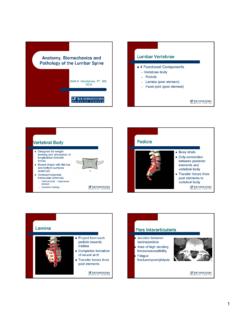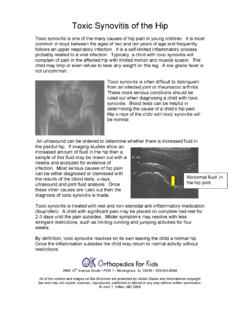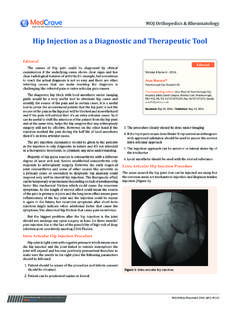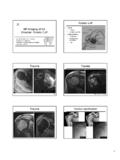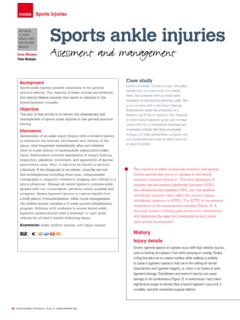Transcription of Temporomandibular DisordersCORE …
1 Julie DeVahl, MS, PT, OCSA ssistant ProfessorDepartment of Physical TherapyTemporomandibular DisordersLearning Objectives: Conduct initial examination and classify patients with TMD. Determine plan of care for patients with TMD. Perform manual therapy for soft-tissue and joint restrictions. Provide patient education for History: Chief complaint Onset, mechanism of injury Pain behavior patterns Red flag screening Medical interventions Occupation Activities of daily living Recreational activitiesExamination Specific Questions may include: Pain when talking, singing, yawning or chewing? Clicking, popping or gravel noises in the jaw? The feeling that your jaw catches or locks? Problems opening or closing your mouth? The habit of grinding or clenching your teeth? A recent change in your bite? Splint or night guard? Dental history, including orthodontics? Ear symptoms?Examination Specific Questions (cont d) Symptoms change (better or worse) with neck movements?
2 Headaches? If yes, where do they start? Neck, shoulder, or back pain? Whiplash or recent injury to your head or neck? Increased stress in your life? A history of arthritis or other medical conditions? Any prescription or over-the-counter medications, herbs, or supplements?Examination Functional Questionnaires: Jaw Functional Limitation Scale Ohrbach et al, 2008 20 item version with good reliability and validity for assessing limitations in mastication, jaw mobility, verbal and emotional expression 8 item version for assessment of global functional limitation Temporomandibular Disorder Disability Index Streigerwald and Maher, 1997 No psychometrics availableExamination What is the patient s goal or expectation?Checklist of Psychological and Behavioral Factors From McNeill 1990 in Dutton 2004 Inconsistent, inappropriate, or vague reports of pain Over dramatization of symptoms Symptoms that vary with life events Significant pain of > 6 months duration Repeated failures with conventional therapies Inconsistent response to medications History of other stress-related disorders Major life events ( new job, marriage, divorce, death) Evidence of drug abuse Clinically significant anxiety or depression Evidence of secondary gainExamination: Posture Sitting and/or standing alignment Occipital protuberance aligned with C7 2 finger-widths of space between base of occiput and C2 McGregor s plane is horizontal Forehead, lips and chin aligned (orthognathic) Retrognathic-posterior Prognathic-anteriorExamination: Posture Forward head posture is common Adaptive: greater mandibular depression Maladaptive.
3 Functional malocclusion and spasm of the lateral pterygoidExamination Facial symmetry Bottom 1/3 of face = top 1/3 of face Masseter hypertrophy or atrophyExamination Facial symmetry Lat. eye-mouth = nose-chin Alignment of central incisorsExamination: AROM Cervical Examine c-spine gross and accessory mobility prior to TMJ Can the patient keep the mouth closed during maximum flexion and extension? During cervical flexion: mandible moves up and forward During cervical extension: mandible moves down and backExamination Mandible AROM Depression-normal opening3 Fingers 40 mm Lateral deviation(excursion)10 mm Protrusion4-6 mm past upper incisors (8-10 mm total)Examination Reliability (ICC)Standard Ruler Walker 2000 DepressionIntra-rater reliability .94 Inter-rater reliability of .99 Lateral deviationIntra-rater reliability . Inter-rater reliability of . ProtrusionIntra-rater reliability .89-93 Inter-rater reliability of .98 MDD =6 mmMagee 2008 Examination: AROM Mandible opening/closing x to mark joint soundsand to mark end range Examination: AROM Palpate condylar movement Anterior to tragus over condyle Posterior to tragus behind condyle 1# pressure used to palpate for tendernessExamination: AROM Auscultation Click, pop, crepitus Document when it occurs Painful or notExamination: PROM Maximum Assisted OpeningPT uses thumb on maxillary incisors and index finger on mandibular incisors to assist with moderate : Strength MMT Grades 0-5/5 Qualifiers: Strong/pain free, Strong/painful, Weak/pain free, Weak/painfulExamination Overpressure (end feel) Normal: tissue stretch Abnormal Hard: osseous abnormalities Springy: displacement of the disc Capsular: adaptive shortening of the periarticular tissuesExamination.
4 Accessory Motions TMJ accessory motions Distraction (inferior, caudal) Anterior glides Medial and lateral glidesMedialLateralExamination: Palpation Muscle Palpation: 2# pressure for extra-oral, 1# for intra-oral Mandible in rest position without teeth contact Press in multiple areas to locate tenderness Note: Hypertonus Local tenderness Referred painExamination: Palpation Temporalis Posterior Middle AnteriorExamination: Palpation Temporalis tendon-intraoral along ramus of mandible Use index finger padExamination: Palpation Masseter Origin Body InsertionExamination: Palpation Medial PterygoidExamination: Palpation Lateral PterygoidExamination: Palpation Accessory MusclesSCM, Scalenes,SuboccipitalsAnt. DigastricsHyoid bone mobility(infrahyoids)Examination: Special Tests Jaw reflex: tap examiner s thumb Chvostek Test: tap parotid gland overlying masseter. Positive test: facial muscles twitch. Implicates involvement of CN : Special Tests Bite Test: place cotton roll or double tongue blades between molars and bite gradually.
5 Assess pain Ipsilateral pain-muscle/tendon irritation Contralateral pain-capsulitis/synovitis Test both sides to confirmDiagnostic Value of Orthopedic Tests in TMD Lobbezoo-Scholte 1993 Tests movement (all directions) Play (manual) pain test (MMT) (muscles)Diagnostic Value of Orthopedic Tests in TMD Lobbezoo-Scholte 1993 Distinguish Patient or Control Passive opening (OR ) Active movements and palpation (OR ) Distinguish Myogenous or Arthrogenous Patients Active movements (OR ) Distinguish Internal Derangement or Osteoarthritis Active movements (OR ) Distinguish ID w/ Reduction or w/o Reduction Active movements ( )Evaluation PT Diagnosis TMD Classification (Olson 2009) Capsulitis/synovitis Capsular fibrosis Masticatory muscle disorders Hypermobility Anterior disc displacement with reduction Anterior disc displacement without reduction OsteoarthritisEvaluation Anterior disc displacement with reduction Stage I: Disc slightly anterior, little to no pain.
6 Repetitive trauma begins to deform disc. Stage II: Reciprocal click early in opening and late in closing phase. Loss of integrity of ligamentous and intracapsular structures, disc deformation and impingement May develop open lockEvaluation Anterior disc displacement without reduction Stage III Most painful stage Reciprocal click occurs later in opening and earlier in closing Closed lock-disc becomes lodged anteriorly (adhesions) Stage IV Clicking is rare, or single opening click Chronic locking w/ soft-tissue remodeling Ant. displaced disc common, but may be Osteoarthritis Stage V Radiographic degenerative changes on condylar head and articular eminences Evidence of remodeling and osteophytes Marked deformity and thickening of disc Narrowed joint spaceResearch Diagnostic CriteriaDworkin and LeResche 1992 Axis I: Clinical TMD ConditionsGroup I:Muscle Myofascial Pain Myofascial Pain with Limited Opening (<40 mm)Group II: Disc With reduction, normal Without reduction, limited Without reduction, normal openingGroup III: Arthralgia- Osteoarthritis-arthralgia and Osteoarthrosis-absence of arthralgiawith bony changesInterventions Education Rest Position of Jaw and Neck Tongue tip on top (rugae) Lips closed Teeth parted Erect posture Diaphragmatic breathing Cervical Posture Sleep: supine preferred Work/school/ADLsEducation Soup Smoothies Milkshakes Ice cream Applesauce Bananas Gelatin Eating Modifications Soft foods include.
7 Scrambled eggs Quiche Baked fish Yogurt Tofu Mashed potatoes PastaEducation Eating Modifications Don t bite into foods such as: Whole apples Carrots or celery Corn on the cob Sandwiches with lettuce Hamburgers Cut foods into bite-sized pieces Grind or finely chop meats or other tough foodsEducation Eating Modifications Avoid hard or chewy foods: Nuts Popcorn Gum Carmel Gummy candies Bread crusts or bagels IceEducation Other Modifications Support your jaw when yawning Tongue tip on top Manual support Avoid loud singing or yelling Avoid biting nails or pencils For desk workers: Headset Computer monitor at eye level Sit with good back support and don t slouchInterventions: Manual Therapy Soft tissue techniques Massage longitudinal, cross friction or circularSCM/ScalenesSubmandibularPterygo ids/MasseterInterventions: Manual TherapyMyofascial Release take up the slack and hold (1-2 min)OccipitalParietal/TemporalisMasseter -elevationMasseter-depressionInterventio ns: Manual Therapy Myofascial ReleaseEar PullInterventions: Manual Therapy Joint mobilization Distraction-for pain control, general joint mobility or reduce condylar head if it is displaced Distraction and anterior translation-improve opening and protrusion or reduce an anteriorly displaced discInterventions: Manual Therapy Joint mobilization Lateral/Medial glides-prep joint for ROM activities, break adhesions, stretch joint capsule or improve lateral deviation.
8 Lateral-thumb on molars (lingual side), fingers on mandible near front teeth Medial-thumb near front teeth (lingual side), fingers on posterior mandible LateralMedialInterventions: Mobility Exercises TMJ rotation and translation control Restore proper tracking to the TMJ Decrease or eliminate clicking, popping or excessive movement Emphasize rotationPhase I: Active assisted-finger on chin and TMJ, tongue on topPhase II: Active-fingers on TMJ, tongue on topPhase III: Fingers in Phase I position, drop tongue at max openingPhase IV: Fingers in Phase II position, drop tongue at max openingMobility: TMJ rotation and translation control Turn the knob and open the door Phase IPhase IIPhase IIIP hase IVInterventions: Mobility Exercises Controlled ROM with Tongue Blade Requires visual cues with mirror Muscle re-ed and AROM post-op Initial training with tongue blade and progress to without Straight opening Lateral deviation ProtrusionInterventions: Mobility Exercises PROM Finger assisted methodInterventions: Mobility Exercises PROM : Stability Exercises Phase I: one finger resistance in rest position Lateral R and L, up, in, diagonal R and LInterventions: Stability Exercises Phase II: one finger resistance with opening one knuckle width Phase III (opt): one finger resistance with opening two knuckles wideInterventions: Stability Exercises Rhythmic Stabilization.
9 Resist depression/ elevation in neutral Progress to one knuckle widthRocabado 6x6 Program6 exercises, 6 reps, 6 ClucksPromotes correct rest TMJ Rotation on OpeningPromotes rotation and prevents excessive Rhythmic StabilizationPromotes normal position of jaw with proper postural alignmentRocabado 6x6 Program4. Upper Cervical DistractionRelieve neurovascular compression by distracting occiput from atlas5. Axial Extension of Cervical SpineNormalize posture6. Shoulder Girdle Retraction & DepressionNormalize postureImpairments: Posture-related Education Soft-tissue mobilization Posture exercises (Wright, et al 2000) Myofacial classification (>6 mos) 3 visits Signif. improvement in MMO, Sx severity, PPT, perceived improvementImpairments: Cervical Muscle Endurance Flexors (Armijo-Olivo, et al. 2010) Extensors (Armijo-Olivo, et al. 2012)Interventions: Modalities Home: heat and/or cold, TENS Clinic US E-stim: IFC, iontophoresis Spray and Stretch EMG biofeedback Low Level LaserInterventions: Modalities TENS electrode placementsInterventions: ModalitiesPost-operative Considerations Arthrocentesis Arthroscopy Arthroplasty with or without Autograft Partial or Complete Joint ReplacementOcclusal Splints Common intervention used by dentists Goal- create single contact for all posterior teeth Evidence does not support general use for nonacute TMD, bruxism and headaches
